spare wheel Citroen C4 PICASSO 2016 2.G Owner's Manual
[x] Cancel search | Manufacturer: CITROEN, Model Year: 2016, Model line: C4 PICASSO, Model: Citroen C4 PICASSO 2016 2.GPages: 527, PDF Size: 13.72 MB
Page 5 of 527
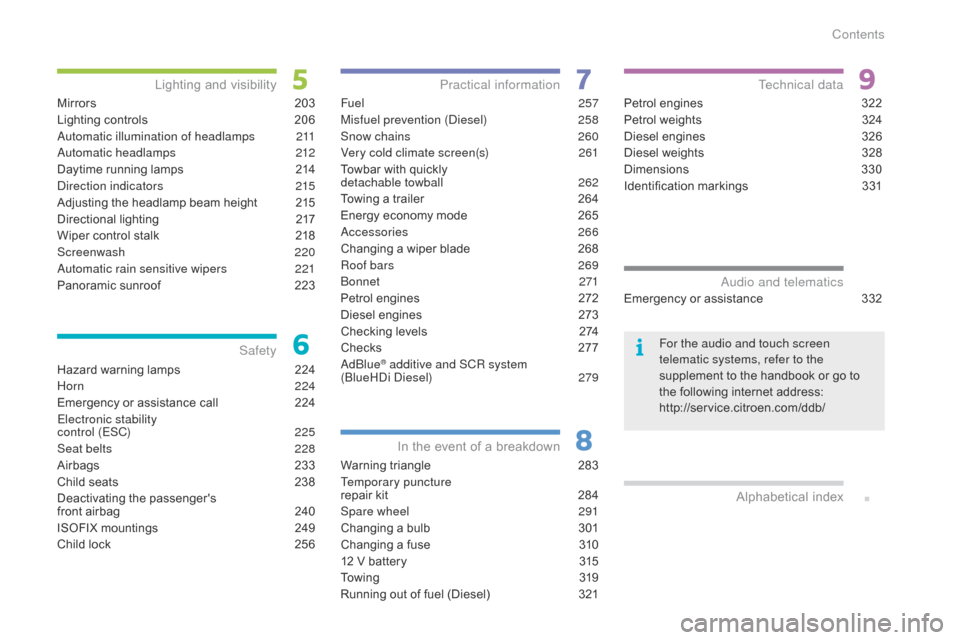
C4-Picasso-II_en_Chap00a_sommaire_ed01-2016
Hazard warning lamps 224
Horn
2
24
Emergency
or assistance call
2
24
Electronic stability
control (ESC)
2
25
Seat belts
2
28
Airbags
2
33
Child
seats
2
38
Deactivating
t
he
p
assenger's
f
ront airbag
2
40
ISOFIX
mountings
2
49
Child
lock
2
56
Safety
Fuel 257
Misfuel prevention (Diesel)
2
58
Snow chains
2
60
Very cold climate screen(s)
2
61
Towbar
with quickly
detachable towball
2
62
Towing
a trailer
2
64
Energy
economy mode
2
65
Accessories
266
Changing
a wiper blade
2
68
Roof bars
2
69
B o nnet
271
Petrol
engines
2
72
Diesel
engines
2
73
Checking
levels
2
74
Checks
2
77
AdBlue
® additive and SCR system
(BlueHDi Diesel) 2 79
Practical information
Warning triangle 2 83
Temporary puncture
repair
kit
2
84
Spare wheel
2
91
Changing
a bulb
3
01
Changing
a fuse
3
10
12
V battery
3
15
To w i n g
3
19
Running
out of fuel (Diesel)
3
21
In the event o f a b reakdown
Petrol engines 3 22
Petrol weights
3
24
Diesel
engines
3
26
Diesel
weights
3
28
Dimensions
3
30
Identification
ma
rkings
3
31
Technical data
Emergency or assistance 332Audio and telematics
Mirrors 203
Lighting controls
2
06
Automatic illumination of headlamps
2
11
Automatic headlamps
2
12
Daytime
running lamps
2
14
Direction indicators
2
15
Adjusting
the headlamp beam height
2
15
Directional
l
ighting
2
17
Wiper
control stalk
2
18
Screenwash
220
Automatic rain sensitive wipers
2
21
Panoramic
sunroof
2
23
Lighting and v isibility
Alphabetical
in
dex
For the audio and touch screen
telematic systems, refer to the
supplement to the handbook or go to
t
he following internet address:
http://service.citroen.com/ddb/
Contents
Page 12 of 527
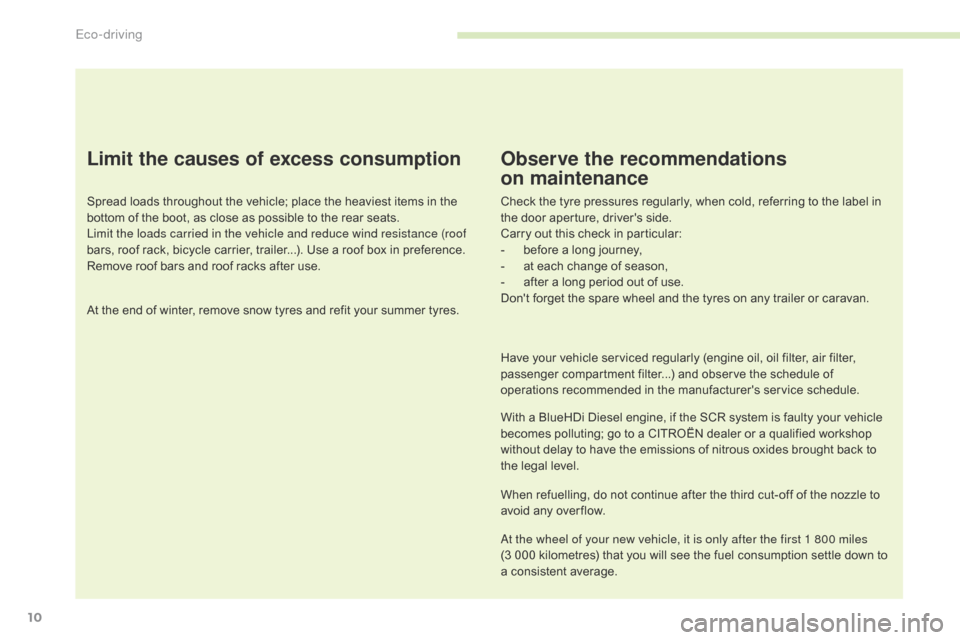
10
C4-Picasso-II_en_Chap00c_eco-conduite_ed01-2016
Limit the causes of excess consumption
Spread loads throughout the vehicle; place the heaviest items in the bottom of the boot, as close as possible to the rear seats.
Limit the loads carried in the vehicle and reduce wind resistance (roof
bars,
roof rack, bicycle carrier, trailer...). Use a roof box in preference.
Remove
roof bars and roof racks after use.
At
the end of winter, remove snow tyres and refit your summer tyres.
Observe the recommendations
on maintenance
Check the tyre pressures regularly, when cold, referring to the label in the door aperture, driver's side.
Carry
out this check in particular:
-
b
efore a long journey,
-
a
t each change of season,
-
a
fter a long period out of use.
Don't
forget the spare wheel and the tyres on any trailer or caravan.
Have
your vehicle serviced regularly (engine oil, oil filter, air filter,
p
assenger compartment filter...) and observe the schedule of
o
perations recommended in the manufacturer's service schedule.
With
a BlueHDi Diesel engine, if the SCR system is faulty your vehicle
b
ecomes polluting; go to a CITROËN dealer or a qualified workshop
w
ithout delay to have the emissions of nitrous oxides brought back to
t
he legal level.
When
refuelling, do not continue after the third cut-off of the nozzle to
a
void any over flow.
At the wheel of your new vehicle, it is only after the first 1 800 miles
(3 000
kilometres) that you will see the fuel consumption settle down to
a
consistent average.
Eco-driving
Page 71 of 527
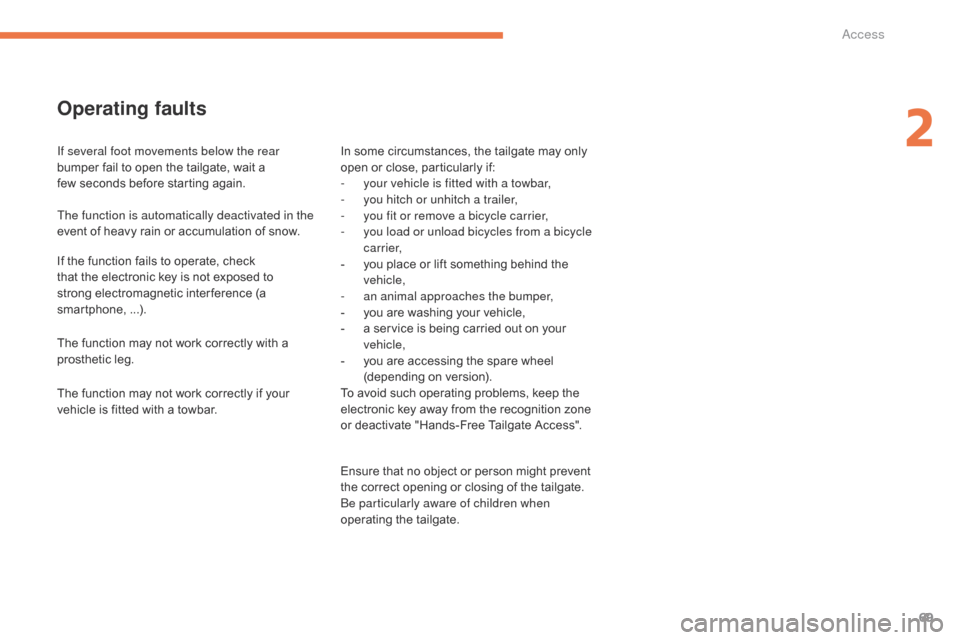
69
C4-Picasso-II_en_Chap02_ouvertures_ed01-2016
Operating faults
If several foot movements below the rear
bumper fail to open the tailgate, wait a
f
ew seconds before starting again.
The function is automatically deactivated in the
event
of heavy rain or accumulation of snow.
If
the function fails to operate, check
t
hat the electronic key is not exposed to
s
trong electromagnetic inter ference (a
s
mar tphone, ...).
The
function may not work correctly with a
pro
sthetic
le
g.
The
function may not work correctly if your
v
ehicle is fitted with a towbar. In
some circumstances, the tailgate may only o
pen or close, particularly if:
-
y
our vehicle is fitted with a towbar,
-
y
ou hitch or unhitch a trailer,
-
y
ou fit or remove a bicycle carrier,
-
y
ou load or unload bicycles from a bicycle
c a r r i e r,
-
y
ou place or lift something behind the
v
ehicle,
-
an
animal approaches the bumper,
-
y
ou are washing your vehicle,
-
a
service is being carried out on your
v
ehicle,
-
y
ou are accessing the spare wheel
(
depending
o
n
v
ersion).
To
avoid such operating problems, keep the
e
lectronic key away from the recognition zone
o
r deactivate "Hands-Free Tailgate Access".
Ensure
that no object or person might prevent
t
he correct opening or closing of the tailgate.
Be particularly aware of children when
operating
the tailgate.
2
Access
Page 176 of 527
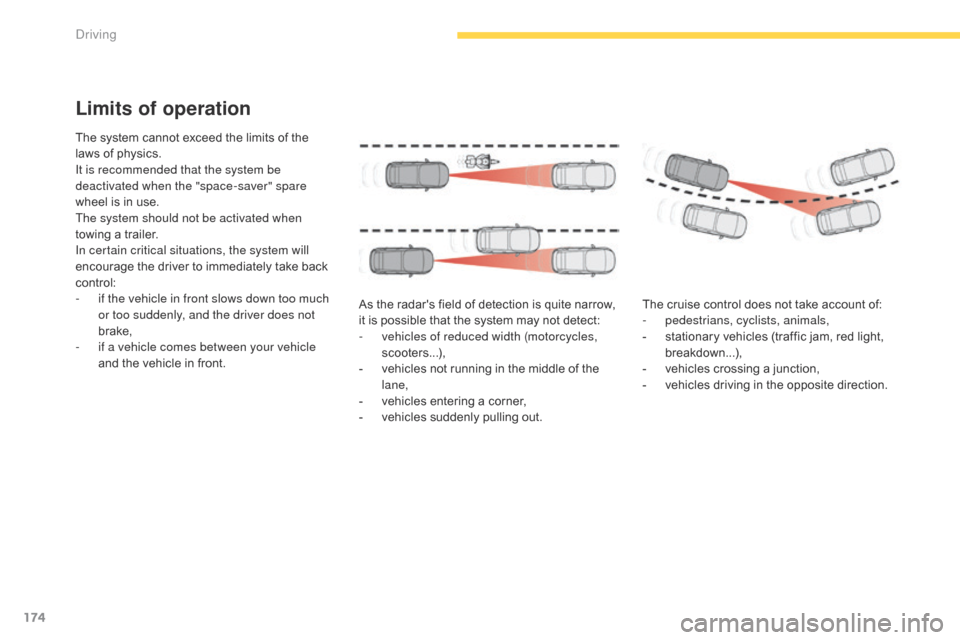
174
C4-Picasso-II_en_Chap04_conduite_ed01-2016
Limits of operation
The system cannot exceed the limits of the laws of physics.
It is recommended that the system be
deactivated when the "space-saver" spare
wheel
is in use.
The system should not be activated when
towing
a trailer.
In certain critical situations, the system will
encourage
the driver to immediately take back
c
ontrol:
-
i
f the vehicle in front slows down too much
or too suddenly, and the driver does not
brake,
-
i
f a vehicle comes between your vehicle
and
the vehicle in front. As
the radar's field of detection is quite narrow,
i
t is possible that the system may not detect:
-
v
ehicles of reduced width (motorcycles,
scooters...),
-
v
ehicles not running in the middle of the
lan
e,
-
v
ehicles entering a corner,
-
v
ehicles suddenly pulling out.The
cruise control does not take account of:
-
p
edestrians, cyclists, animals,
-
s
tationary vehicles (traffic jam, red light,
b
reakdown...),
-
v
ehicles crossing a junction,
-
v
ehicles driving in the opposite direction.
Driving
Page 182 of 527
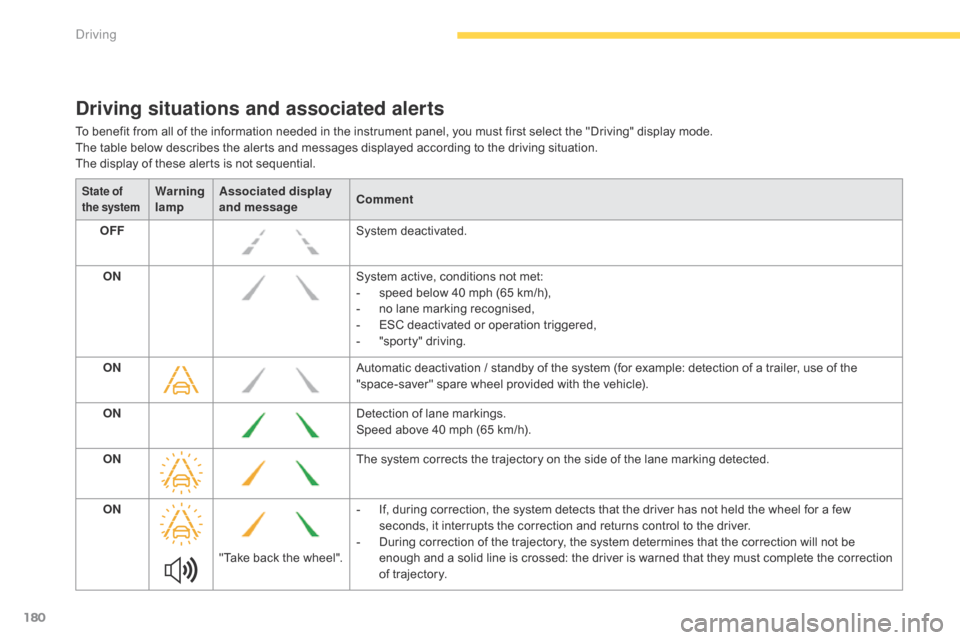
180
C4-Picasso-II_en_Chap04_conduite_ed01-2016
Driving situations and associated alerts
To benefit from all of the information needed in the instrument panel, you must first select the "Driving" display mode.
T he table below describes the alerts and messages displayed according to the driving situation.
The
display of these alerts is not sequential.
State of
the systemWarning
lamp Associated display
and message
Comment
OFF System
d
eactivated.
ON System
active, conditions not met:
-
s
peed below 40 mph (65 km/h),
-
n
o lane marking recognised,
-
ES
C deactivated or operation triggered,
-
"
sporty" driving.
ON Automatic
deactivation / standby of the system (for example: detection of a trailer, use of the
"
space-saver" spare wheel provided with the vehicle).
ON Detection
of lane markings.
Speed
above 40 mph (65 km/h).
ON The
system corrects the trajectory on the side of the lane marking detected.
ON "Take
back the wheel".-
I
f, during correction, the system detects that the driver has not held the wheel for a few
s
econds, it interrupts the correction and returns control to the driver.
-
D
uring correction of the trajectory, the system determines that the correction will not be
e
nough and a solid line is crossed: the driver is warned that they must complete the correction
o
f trajectory.
Driving
Page 183 of 527

181
C4-Picasso-II_en_Chap04_conduite_ed01-2016
Limits of operation
The system goes into standby automatically in the following cases:
-
ES
C deactivated or operation
triggered,
-
s
peed below 40 mph (65 km/h) or
a
bove 112 mph (180 km/h),
-
c
onnected electrically to a trailer,
-
u
se of the "space-saver" spare
wheel detected (as detection is
not immediate, deactivation of the
system is recommended),
-
d
ynamic driving style detected,
p
ressure on the brake or
a
ccelerator pedal,
-
d
riving where there are no lane
ma
rkings,
-
ope
ration of the direction indicators,
-
d
riving in a tight corner,
-
i
nactivity by the driver detected
during
c
orrection. The system may not operate correctly
or
at all in the following situations:
-
c
onditions of poor visibility
(inadequate
street lighting,
s
nowfall, rain, fog),
-
d
azzle (headlamps of on oncoming
v
ehicle, low sun, reflections on a
wet
road sur face, leaving a tunnel,
a
lternating light and shade),
-
a
rea of the windscreen in front of
the camera dirty, misted, frosted,
snow-covered,
damaged or
c
overed by a sticker,
-
r
oad markings absent, worn,
h
idden (snow, mud) or multiple
(roadworks),
-
r
unning close to the vehicle in front
(
the lane markings may not be
d
etected),
-
n
arrow, twisty roads.Risk of undesirable operation
Deactivation of the system is recommended in
the following situations:
-
d
riving on a road sur face in poor condition,
-
u
nfavorable weather conditions,
-
d
riving on slippery sur faces (black ice).
The
system is not designed for the following
d
riving
s
ituations:
-
d
riving on a speed circuit,
-
d
riving with a trailer,
-
d
riving on a rolling road,
-
d
riving on unstable sur faces.
In the event of a fault with the system, you are
alerted
by the illumination of these warning
lam
ps in the instrument panel, accompanied by
the
display of a message and an audible signal.
Have
the system checked by a CITROËN
d
ealer or a qualified workshop.
Operating fault
4
Driving
Page 203 of 527
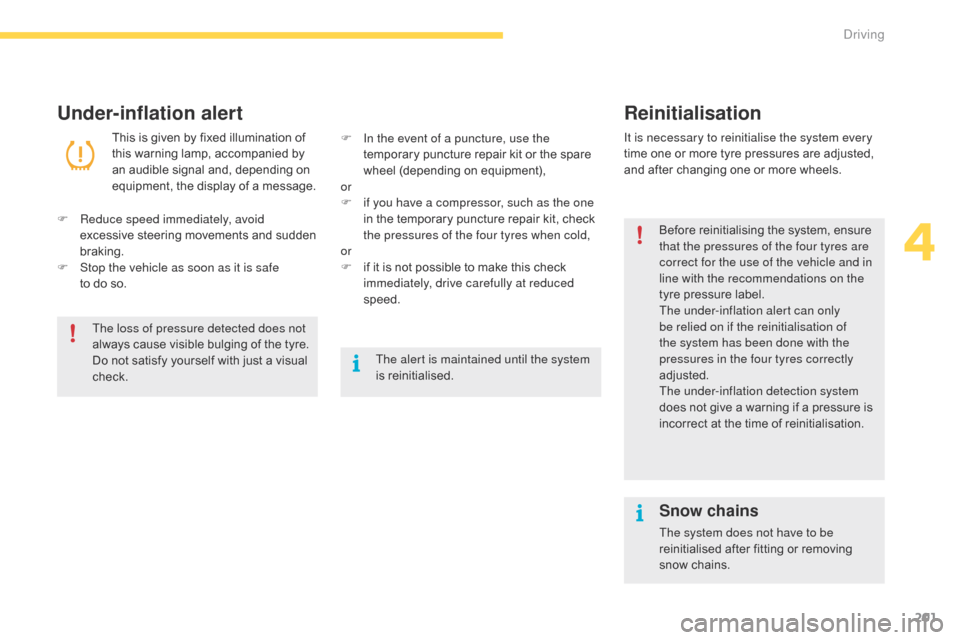
201
C4-Picasso-II_en_Chap04_conduite_ed01-2016
Under-inflation alertReinitialisation
This is given by fixed illumination of t
his warning lamp, accompanied by
a
n audible signal and, depending on
e
quipment, the display of a message. It is necessary to reinitialise the system every
time
one or more tyre pressures are adjusted,
a
nd after changing one or more wheels.
F
R
educe speed immediately, avoid
excessive
steering movements and sudden
b
raking.
F
S
top the vehicle as soon as it is safe
to
do
so. F
I n the event of a puncture, use the
temporary
puncture repair kit or the spare
w
heel (depending on equipment),
or
F
i
f you have a compressor, such as the one
in
the temporary puncture repair kit, check
t
he pressures of the four tyres when cold,
or
F
i
f it is not possible to make this check
i
mmediately, drive carefully at reduced
speed.
The loss of pressure detected does not
always
cause visible bulging of the tyre.
D
o
not satisfy yourself with just a visual
c
heck. The alert is maintained until the system
is
r
einitialised.
Snow chains
The system does not have to be
reinitialised after fitting or removing
sn
ow
c
hains.
Before
reinitialising the system, ensure
t
hat the pressures of the four tyres are
correct for the use of the vehicle and in
line with the recommendations on the
tyre pressure label.
The under-inflation alert can only
be relied on if the reinitialisation of
the system has been done with the
pressures in the four tyres correctly
adjusted.
The under-inflation detection system
does not give a warning if a pressure is
i
ncorrect at the time of reinitialisation.
4
Driving
Page 262 of 527
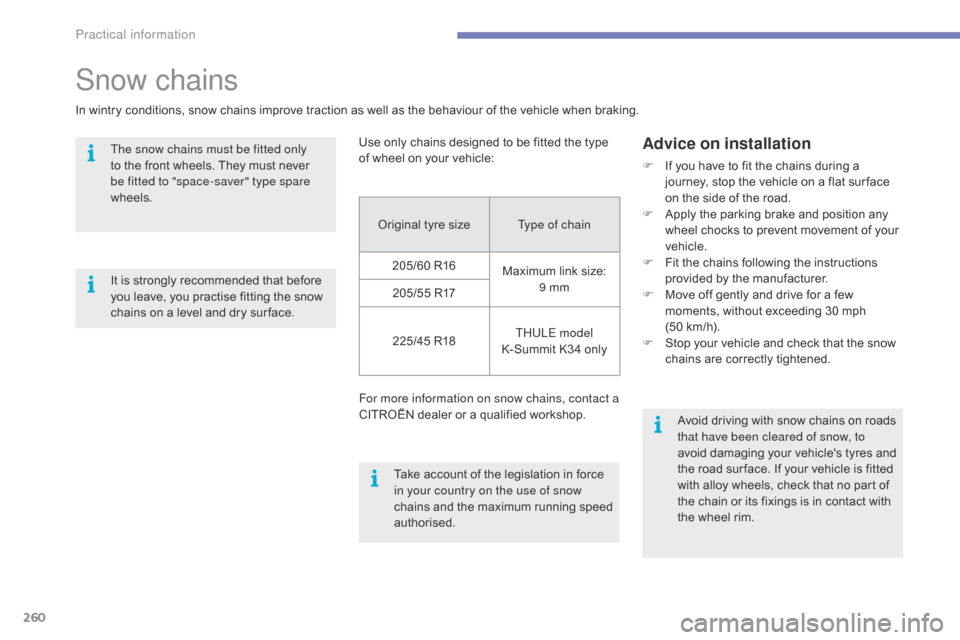
260
C4-Picasso-II_en_Chap07_info-pratiques_ed01-2016
Original tyre sizeT ype of chain
205/60 R16 Maximum
link size:
9 m
m
205/55
R17
225/45
R18 THULE model
K-Summit
K34 only
For more information on snow chains, contact a
CITROËN
dealer or a qualified workshop.
Use
only chains designed to be fitted the type
o
f
wheel on your vehicle:
Snow chains
In wintry conditions, snow chains improve traction as well as the behaviour of the vehicle when braking.
T he snow chains must be fitted only
to
the front wheels. They must never
b
e fitted to "space-saver" type spare
wheels.
Advice on installation
F If you have to fit the chains during a j
ourney, stop the vehicle on a flat sur face
o
n the side of the road.
F
A
pply the parking brake and position any
w
heel chocks to prevent movement of your
v
ehicle.
F
F
it the chains following the instructions
p
rovided by the manufacturer.
F
M
ove off gently and drive for a few
m
oments, without exceeding 30 mph
(
50 km/h).
F
S
top your vehicle and check that the snow
c
hains are correctly tightened.
Take
account
of
the
legislation
in
force
i
n your country on the use of snow
chains
and
the
maximum
running
speed
a
uthorised. Avoid
driving with snow chains on roads
t
hat have been cleared of snow, to
avoid
damaging your vehicle's tyres and
t
he road sur face. If your vehicle is fitted
w
ith alloy wheels, check that no part of
t
he chain or its fixings is in contact with
t
he wheel rim.
It
is
strongly
recommended
that
before
y
ou
leave,
you
practise
fitting
the
snow
c
hains
on
a
level
and
dry
sur face.
Practical information
Page 293 of 527
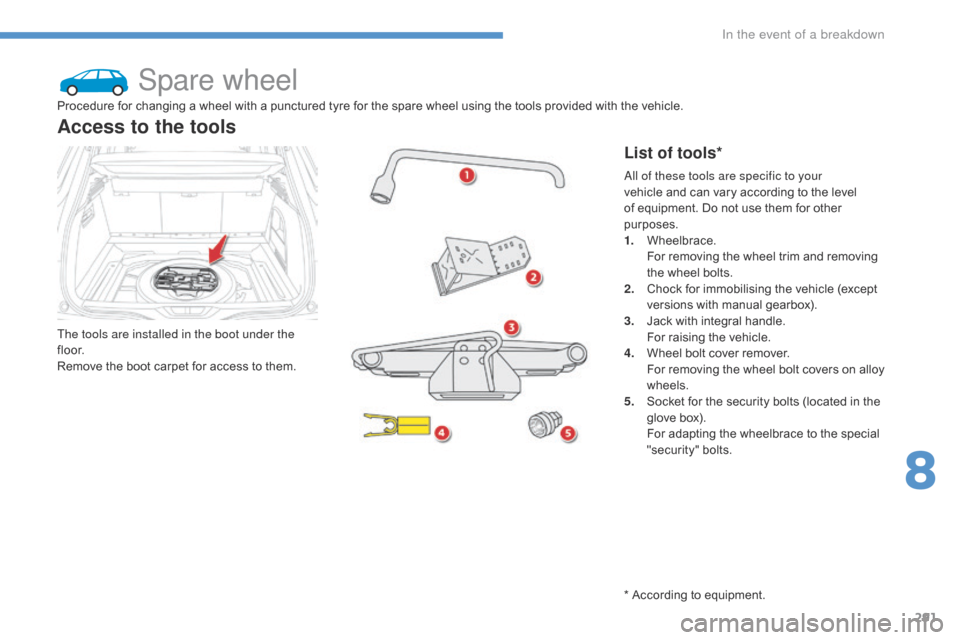
291
C4-Picasso-II_en_Chap08_en-cas-panne_ed01-2016
Spare wheel
The tools are installed in the boot under the
f l o o r.
Remove the boot carpet for access to them.
Access to the tools
List of tools*
Procedure for changing a wheel with a punctured tyre for the spare wheel using the tools provided with the vehicle.
A ll of these tools are specific to your
vehicle
and can vary according to the level
o
f equipment. Do not use them for other
p
urposes.
1.
W
heelbrace.
F
or removing the wheel trim and removing
t
he wheel bolts.
2.
C
hock for immobilising the vehicle (except
v
ersions with manual gearbox).
3.
J
ack with integral handle.
F
or raising the vehicle.
4.
W
heel bolt cover remover.
F
or removing the wheel bolt covers on alloy
w
heels.
5.
S
ocket for the security bolts (located in the
g
love box).
F
or adapting the wheelbrace to the special
"s
ecurity"
b
olts.
*
According to equipment.
8
In the event of a breakdown
Page 294 of 527
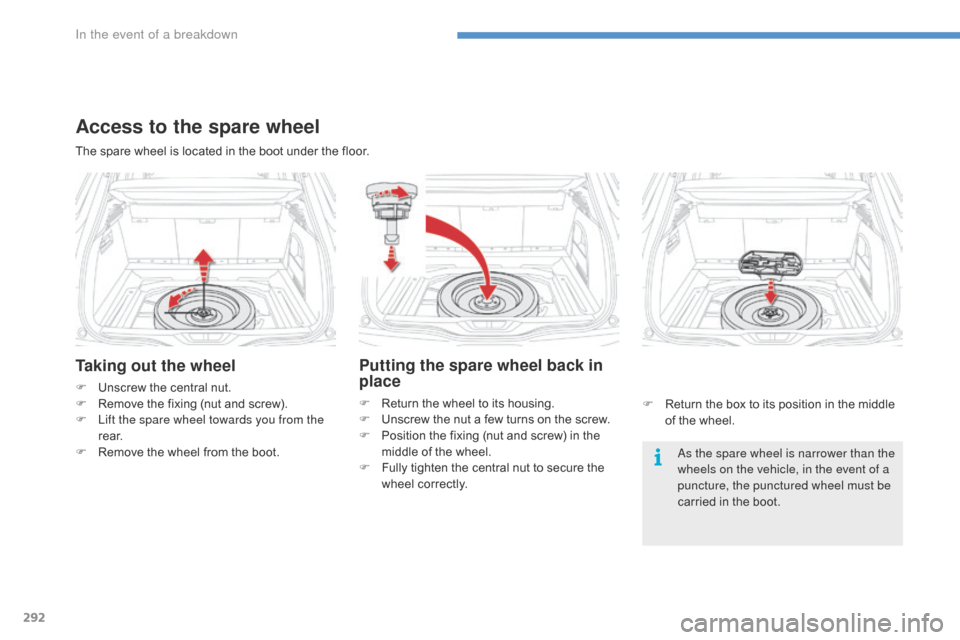
292
C4-Picasso-II_en_Chap08_en-cas-panne_ed01-2016
Taking out the wheel
F Unscrew the central nut.
F R emove the fixing (nut and screw).
F
L
ift the spare wheel towards you from the
r e a r.
F
R
emove the wheel from the boot. As the spare wheel is narrower than the
wheels on the vehicle, in the event of a
puncture, the punctured wheel must be
carried
in the boot.
The
spare wheel is located in the boot under the floor.
Access to the spare wheel
Putting the spare wheel back in
place
F Return
the wheel to its housing.
F U nscrew the nut a few turns on the screw.
F
P
osition the fixing (nut and screw) in the
m
iddle of the wheel.
F
F
ully tighten the central nut to secure the
w
heel correctly. F
R eturn the box to its position in the middle
o
f the wheel.
In the event of a breakdown